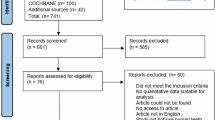Abstract
Data sources
Medline and the OpenThesis database.
Study selection
Randomised clinical trials (RCTs) and cohort studies comparing the incidence of root fractures of metallic and fibre-reinforced composite posts with more than five years follow up were considered.
Data extraction and synthesis
Two reviewers independently selected studies and assessed study quality. The Cochrane risk of bias tool was used to assess RCTs and the Newcastle-Ottawa Scale for cohort studies. Root fracture leading to tooth extraction was considered a catastrophic failure and defined as the primary outcome. Secondary outcomes (non-catastrophic failures) included endodontic failures, crown dislodgement, post debonding, and post/core fractures. The incidence rate of root fractures and non-catastrophic failures was calculated by dividing the number of events by the period of risk for all included posts during the study period per 1000 post years of follow-up.
Results
Fourteen studies (seven RCTs and seven cohorts) were included involving 3202 patients and 4752 posts. In all there were 62 root fractures and 467 non-catastrophic failures.
The incidence rate of root fractures (pooled event rate per 1000 post years) for metal posts (four RCTs, four cohorts) was 5.13 (95% CI, 4.05–6.21) compared with 4.78 (95% CI, 4.28–5.27) for the fibre-reinforced posts (five RCTs, three cohorts). The pooled survival rate for was metal posts = 90% (95% CI 85.5– 93.3) compared with 83.9% (95% 67.6–92.8) for fibre-reinforced posts. Heterogeneity between the studies was high. The incidence rate of non-catastrophic failures for metal-based posts (four RCTs, 3 cohorts) was 12.69 (95% CI, 7.90–17.48) per 1000 post years compared with 19.39 (95% CI, 13.21–25.57) for fibre-reinforced posts. Heterogeneity was again important.
Conclusions
The results of the present systematic review based on clinical studies do not support the indication of fibre-reinforced posts based on a reduction of catastrophic failures. However, this review also showed the need for further well designed clinical studies evaluating intra-radicular posts.
Similar content being viewed by others
Log in or create a free account to read this content
Gain free access to this article, as well as selected content from this journal and more on nature.com
or
References
Bateman G, Ricketts DN, Saunders WP . Fibre-based post systems: a review. Br Dent J 2003; 195: 43–48: discussion 37.
Rosenstiel SF, Land MF . Contemporary Fixed Prosthodontics 3rd Mosy Inc St Louis 2001, p.276-283.
King PA, Setchell DJ, Rees JS . Clinical evaluation of a carbon fibre reinforced carbon endodontic post. J Oral Rehabil 2003; 30: 785–789.
Sterzenbach G, Franke A, Naumann M . Rigid versus flexible dentine-like endodontic posts--clinical testing of a biomechanical concept: seven-year results of a randomized controlled clinical pilot trial on endodontically treated abutment teeth with severe hard tissue loss. J Endod 2012; 38: 1557–1563.
Last, J M ., A Dictionary of Epidemiology (4th ed) (2001). New York, NY: Oxford University Press. p.92
Stewart LA, Tierney JF . To IPD or not to IPD? Advantages and disadvantages of systematic reviews using individual patient data. Eval Health Prof 2002; 25: 76–97.
Author information
Authors and Affiliations
Additional information
Address for correspondence: Dr Andre Luis Faria-e-Silva, Universidade Federal de Sergipe, Hospital Universitario, Departamento de Odontologia, Rua Claudio Batista, s/n Bairro Sanatorio, Aracaju, Sergipe, Brazil, CEP 49060-100. E-mail: fariaesilva.andre@gmail.com
Figueiredo FE, Martins-Filho PR, Faria-E-Silva AL. Do metal post-retained restorations result in more root fractures than fiber post-retained restorations? A systematic review and meta-analysis. J Endod 2015; 41: 309–316.
Rights and permissions
About this article
Cite this article
Balevi, B. Metal or fibre posts and root fractures. Evid Based Dent 16, 80–81 (2015). https://doi.org/10.1038/sj.ebd.6401115
Published:
Issue date:
DOI: https://doi.org/10.1038/sj.ebd.6401115



